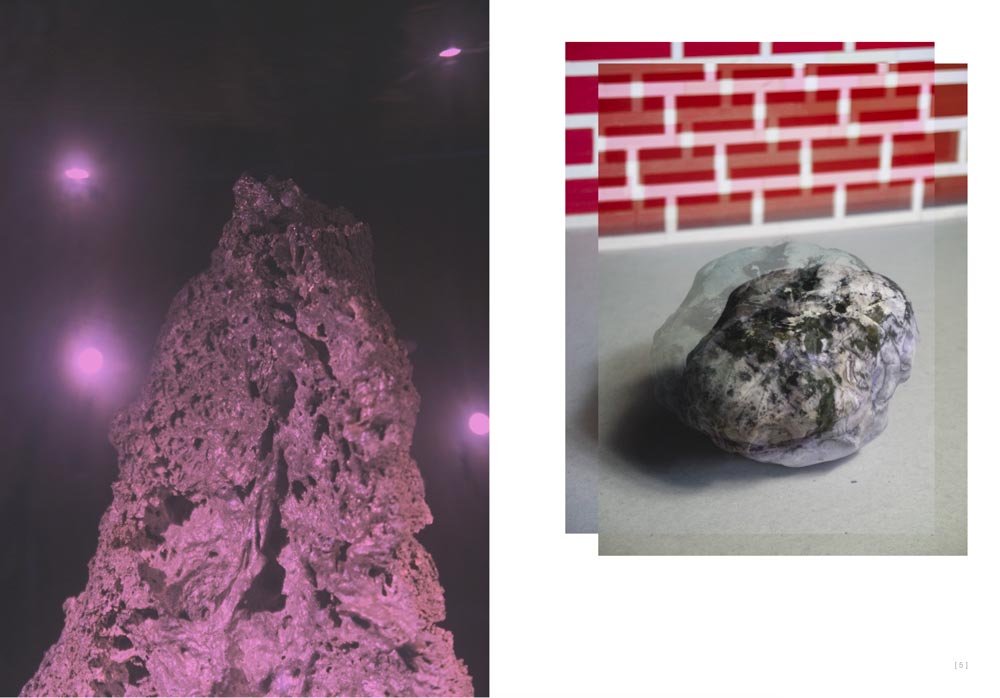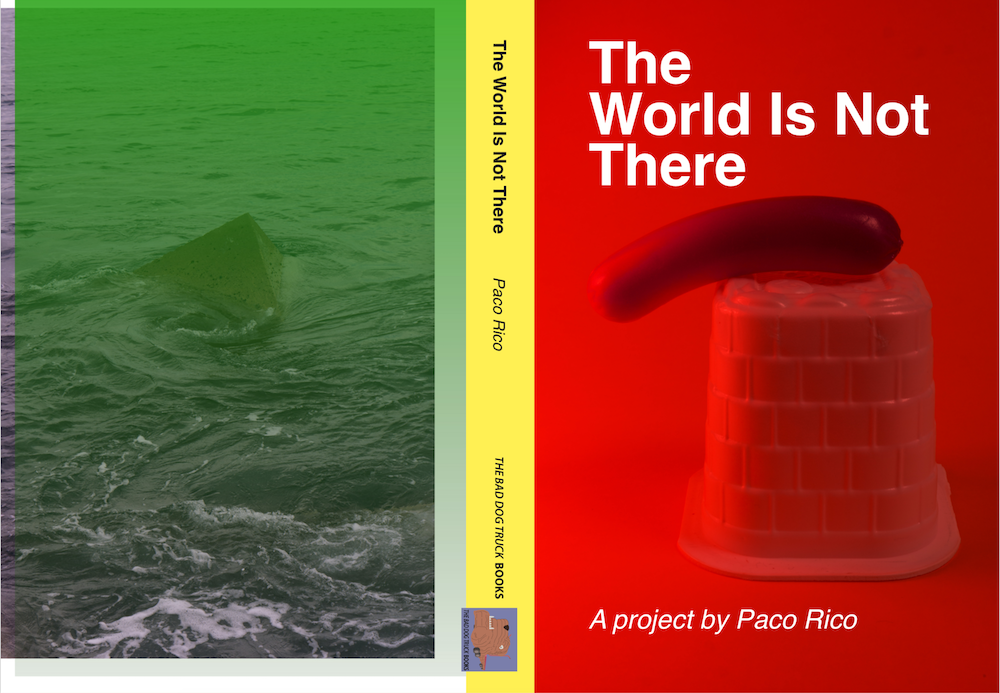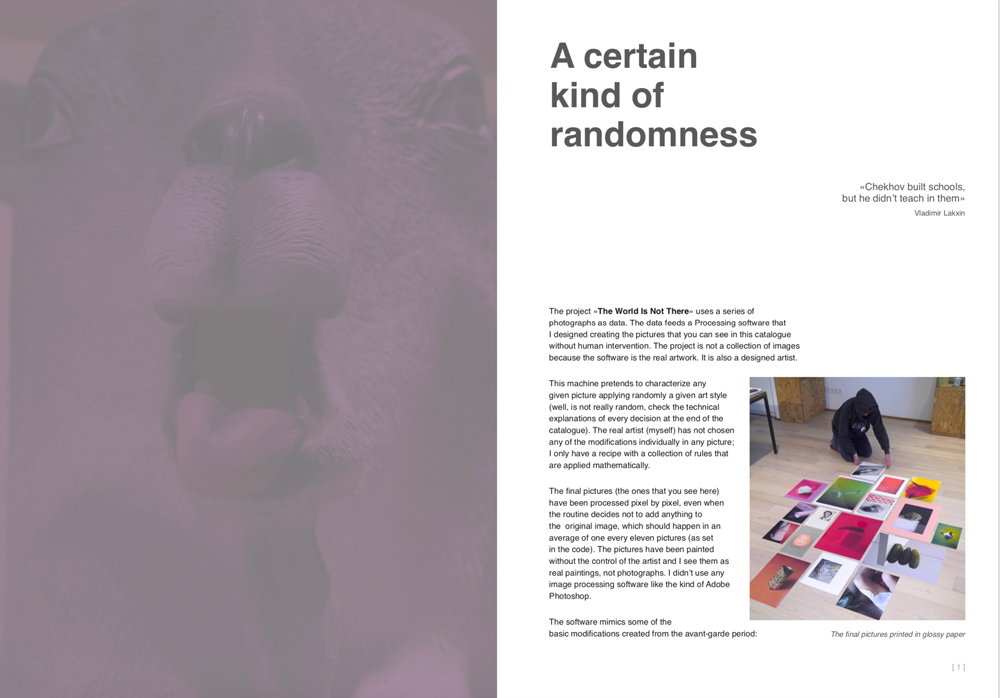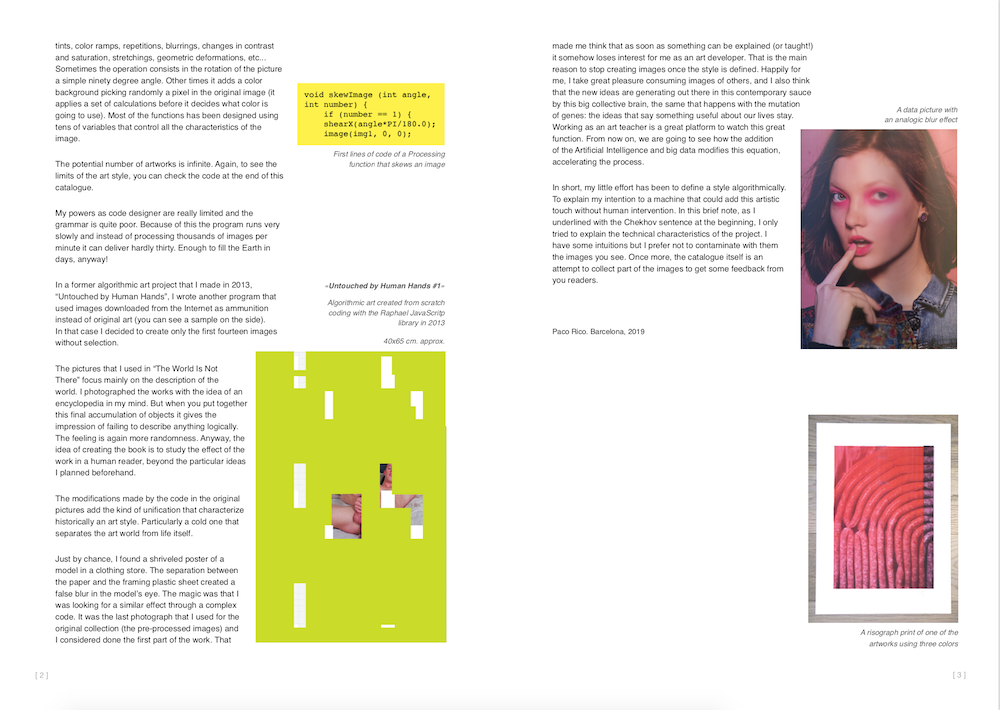Warning: Trying to access array offset on value of type bool in /home2/pacorico/public_html/wp-content/themes/Workality-Lite-master/functions.php on line 303
Warning: Trying to access array offset on value of type bool in /home2/pacorico/public_html/wp-content/themes/Workality-Lite-master/functions.php on line 303
Blog
The World Is Not There: the book
Finally I decided to make a book with some of the pictures of the project. Soon you will be able to buy a copy for just 15€ (96 pages, all color, 21×30 cm., softcover). It will include also the Processing software that I wrote for the project.
This is the cover and the first pages published by the prestigious The Bad Dog Truck Books.
 This text explains basically the funcionality of the processing code that I wrote in order to modify my original photographs:
This text explains basically the funcionality of the processing code that I wrote in order to modify my original photographs:
The World Is Not There
A certain kind of randomness
«Chekhov built schools, but he didn’t teach in them»
Vladimir Lakxin
The project «The World Is Not There» uses a series of photographs as data. The data feeds a Processing software that I designed creating the pictures that you can see in this catalogue without human intervention. The project is not a collection of images because the software is the real artwork. It is also a designed artist.
This machine pretends to characterize any given picture applying randomly a given art style (well, is not really random, check the technical explanations of every decision at the end of the catalogue). The real artist (myself) has not chosen any of the modifications individually in any picture; I only have a recipe with a collection of rules that are applied mathematically.
The final pictures (the ones that you see here) have been processed pixel by pixel, even when the routine decides not to add anything to the original image, which should happen in an average of one every eleven pictures (as set in the code). The pictures have been painted without the control of the artist and I see them as real paintings, not photographs. I didn’t use any image processing software like the kind of Adobe Photoshop.
The software mimics some of the basic modifications created from the avant-garde period: reframings, minimal tints, color ramps, repetitions, blurrings, changes in contrast and saturation, stretchings, geometric deformations, etc… Sometimes the operation consists in the rotation of the picture a simple ninety degree angle. Other times it adds a color background picking randomly a pixel in the original image (it applies a set of calculations before it decides what color is going to use). Most of the functions has been designed using tens of variables that control all the characteristics of the image.
The potential number of artworks is infinite. Again, to see the limits of the art style, you can check the code at the end of this catalogue.
My powers as code designer are really limited and the grammar is quite poor. Because of this the program runs very slowly and instead of processing thousands of images per minute it can deliver hardly thirty. Enough to fill the Earth in days, anyway!
In a former algorithmic art project that I made in 2013, “Untouched by Human Hands”, I wrote another program that used images downloaded from the Internet as ammunition instead of original art (you can see a couple of them on the side). In that case I decided to create only the first fourteen images without selection.
The pictures that I used in “The World Is Not There” focus mainly on the description of the world. I photographed the works with the idea of an encyclopedia in my mind. But when you put together this final accumulation of objects it gives the impression of failing to describe anything logically. The feeling is again more randomness. Anyway, the idea of creating the book is to study the effect of the work in a human reader, beyond the particular ideas I planned beforehand.
The modifications made by the code in the original pictures add the kind of unification that characterize historically an art style. Particularly a cold one that separates the art world from life itself.
Just by chance, I found a shriveled poster of a model in a clothing store. The separation between the paper and the framing plastic sheet created a false blur in the model’s eye. The magic was that I was looking for a similar effect through a complex code. It was the last photograph that I used for the original collection (the pre-processed images) and I considered done the first part of the work. That made me think that as soon as something can be explained (or taught!) it somehow loses interest for me as an art developer. That is the main reason to stop creating images once the style is defined. Happily for me, I take great pleasure consuming images of others, and I also think that the new ideas are generating out there in this contemporary sauce by this big collective brain, the same that happens with the mutation of genes: the ideas that say something useful about our lives stay. Working as an art teacher is a great platform to watch this great function. From now on, we are going to see how the addition of the Artificial Intelligence and big data modifies this equation, accelerating the process.
In short, my little effort has been to define a style algorithmically. To explain my intention to a machine that could add this artistic touch without human intervention. In this brief note, as I underlined with the Chekhov sentence at the beginning, I only tried to explain the technical characteristics of the project. I have some intuitions but I prefer not to contaminate with them the images you see. Once more, the catalogue itself is an attempt to collect part of the images to get some feedback from you readers.
Paco Rico. Barcelona, 2019




